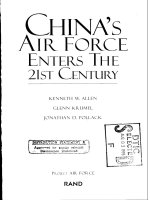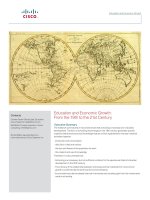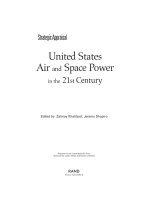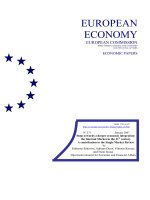- Trang chủ >>
- Mầm non - Tiểu học >>
- Lớp 5
5 6 4 flying into the 21st century TG
Bạn đang xem bản rút gọn của tài liệu. Xem và tải ngay bản đầy đủ của tài liệu tại đây (121.32 KB, 4 trang )
Flying into the
21st Century
SUMMARY
Join the García family, 21st
century travelers, as they take a plane from
Chicago to Denver. Grandma reflects on
how—from ticketing to checking in to inflight entertainment—flying has come a long
way. This book talks about the future of
commercial space flight as well.
LESSON VOCABULARY
agent
confiscate
kiosk
taxis
altitude
cruising
tarmac
turbulence
INTRODUCE THE BOOK
INTRODUCE THE TITLE AND AUTHOR
Discuss with
students the title and author of Flying into the
21st Century. Invite students to say what this
book might be about, based on the title.
BUILD BACKGROUND
Discuss what students
know about the early history of airplanes. Ask
if they know the names of the inventors of the
first aircraft (Wilbur and Orville Wright). Ask
how air travel today is different than it was
twenty years ago.
PREVIEW/USE TEXT FEATURES
Invite students
to preview the book by looking at heads,
illustrations, photos, and captions. Ask them
to consider how these features add to the
book. Invite them to say why they think the
map on pages 12–13 is included. Ask: What
are time zones?
READ THE BOOK
SET PURPOSE
Guide students to set their own
purposes for reading the selection. Students’
interest in airplanes and the history of flight
should guide this purpose. Invite them to
consider how airplane travel has changed over
the years and how it might still change in the
years to come.
124
5.6.4
FACT AND OPINION
ASK QUESTIONS
STRATEGY SUPPORT: ASK QUESTIONS
Invite the
students to record their questions as they
read. Afterwards, have them use the book,
other references, or personal activities to
answer their own questions. Have them
exchange papers with a partner and read his
or her questions and answers. Have partners
note which questions they have in common.
Have them discuss methods they used to
answer their questions.
Invite more proficient peers to work
with less proficient peers to record their
questions or help them formulate their
questions. They may wish to use a graphic
organizer to record their questions before,
during, and after reading the book.
COMPREHENSION QUESTIONS
PAGE 3 How did the Wright brothers reward
Charley Furnas? What did they reward him
for? (by making him the first American air
passenger; for helping them in his spare time)
PAGE 6
What are e-tickets? (electronic tickets
issued by the airline and created online)
PAGE 10 What is one way commercial air travel
today is different from earlier times? (much
of the navigation is automated)
PAGE 13
In addition to monitoring the
electronic tracking system, what do air traffic
controllers do before giving the final clearance
to land? (They scan the sky and runways with
binoculars.)
PAGE 20
“Computers will likely play an even
bigger role in future air travel.” Is this a
statement of fact or of opinion? Explain.
(A statement of opinion; It is one person’s
opinion of what might happen in the future.)
Flying into the 21st Century
16924_LRD_TG_124-125 124
12/16/05 9:13:36 AM
REVISIT THE BOOK
READER RESPONSE
1. Possible response: Fact: Mechanics check
to make sure the airplane is safe to fly.
Opinion: It is probably the most important
step in preparing the airplane for its next
flight.
2. Answers may vary but might include:
How much will it cost? How long will
I be in outer space? How safe is this?
What are the risks?
3. Students should list unfamiliar words from
the selection, look them up, and record
the definitions. They should say whether
they were able to guess the contextual
meaning based on words or phrases
in the paragraph.
4. Responses will vary.
EXTEND UNDERSTANDING
Invite students to say
which photos or illustrations interest them the
most. Ask them to explain how these features
add to their prior knowledge about the history
of flight and airplane travel.
RESPONSE OPTIONS
WRITING
Invite students to write about a time
they flew on an airplane. Have them describe
checking in at the airport, getting on the
plane, the take-off, flight, landing, and getting
their luggage. Students who have never flown
can write a fictional account of a flight they
would like to take. Encourage them to include
their point of departure and their destination.
SOCIAL STUDIES
CONNECTION
Students can find out
more about the earliest
flying machines or about the future
of commercial space travel by visiting
the library or using the Internet. Have them
draw pictures of early airplanes or futuristic
spacecraft. Have them label their pictures and
exhibit them to the class.
Skill Work
TEACH/REVIEW VOCABULARY
Invite students to form two teams. Have
one team read the definition of a vocabulary
word. Have the teams reverse roles.
Continue in a similar fashion with the
remaining vocabulary words.
TARGET SKILL AND STRATEGY
FACT AND OPINION Tell students that
a statement of fact can be proved true
or false, while a statement of opinion
is a statement of someone’s judgment,
belief, or way of thinking about something.
Invite students, as they read, to look for
statements of fact and statements of
opinion. Then, have them cite personal
activities (observing, weighing, measuring,
and so on) they could use to verify
whether the statements of fact are true
or false. They may also cite references
(encyclopedias and Internet sites).
ASK QUESTIONS
Remind students that
good readers ask good questions about
important text information. Explain that
asking questions can also help them
distinguish statements of fact from
statements of opinion, and verify or disprove
statements of fact. Model some questions
such as, “How has the author organized
the information? Why did the author include
this piece of information? Is this a statement
of fact or a statement of opinion? What
information supports your answer?”
ADDITIONAL SKILL INSTRUCTION
SETTING Remind students that the setting is
the time and place in which a story occurs.
Explain that, although this book is factual, it
tells about a real family and their experiences
traveling from Chicago to Denver in the
present day—the 21st century. The story
takes place in their home, in the airport,
and in the airplane. That is the setting.
Explain that the setting is important to this
book because it deals with modern air-travel
technology.
Flying into the 21st Century
16924_LRD_TG_124-125 125
125
12/16/05 9:13:38 AM
Name
Flying into the 21st Century
Fact and Opinion
• A statement of fact is a statement that can be proved true or false.
• A statement of opinion tells someone’s ideas, feelings, or beliefs. It cannot be proved true or false.
Directions Read the sentences below. On the line beside each sentence, write either fact or opinion.
Give a reason for your response.
1. Charley Furnas, a mechanic by profession, was an airplane enthusiast who enjoyed helping the
Wright brothers in his spare time.
2. Being an airplane passenger has changed a lot over the nearly hundred years since Charley Furnas
first flew.
3. Perhaps the most exciting future possibility is that ordinary people will be able to fly in
spacecraft.
4. On Melville’s first flight in SpaceShipOne, he left Earth’s atmosphere and reached an altitude
of 62 miles.
5. The conveyor belt moves carry-on items through an x-ray machine that allows security
personnel to see inside everything.
6. Buying tickets online is better than buying them from a travel agent.
8. Much of the navigation of today’s commercial jets is automated.
9. When Grandma was a young woman, there were no movies, music, and telephones on airplanes.
© Pearson Education 5
7. People should not have to put up with the delays caused by security checks at airports.
10. Air traffic control plays a crucial role in air travel.
126
16924_LRD_TG_126-127 126
12/16/05 9:14:16 AM
Flying into the 21st Century
Name
Vocabulary
Directions Choose the word from the box that best matches each definition.
Write the word on the line.
Check the Words You Know
agent
altitude
confiscate
cruising
kiosk
tarmac
taxis
turbulence
1.
small structure with wide open sides
2.
rough air encountered in flight
3.
a person who does business for someone else
4.
take away by force
Directions Write the word from the box that belongs in each group.
5. depth, height,
6. sidewalk, pavement,
7. traveling, driving,
8. steers, guides,
© Pearson Education 5
Directions Write a short paragraph on the future of commercial space flight. Use as many vocabulary
words as possible.
127
16924_LRD_TG_126-127 127
12/16/05 9:14:17 AM









